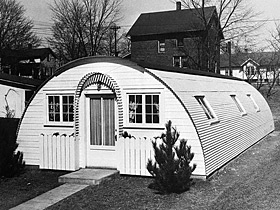You may have heard them advertised on television, radio, online and in the back of Popular Mechanics.
I came across a query from a gentleman from Wake Forest, NC which included, “I have found some really good deals on the local craigslist from private individuals who have bought them and never put them up for one reason or another.” He wanted, “…to hear anyone’s input, good or bad. Yes, there are a lot of horror stories out there about poor schmucks that got hosed trying to buy from some less-than-scrupulous purveyors of these structures, but like I said, I plan on purchasing from a private individual who already has it in his possession.”

Now all of this got me thinking, so I started my research. It turns out the Quonset hut was named for the site of their first manufacture – Quonset Point, Rhode Island. First built for the Navy in 1941, as many as 170,000 Quonset huts were manufactured during World War II.
According to Wikipedia, “The erection of Quonset huts has been banned in the US state of Alaska for many years due to so many already being in the state and the majority of those falling into disrepair and becoming environmental hazards.”
I’ve never been involved in the construction of a Quonset hut myself, as my background is in conventional stick frame and pole buildings. Due to this, I relied upon the experiences of three people.
When I was a contractor, Jay and his crew subcontracted labor on several pole barns we sold. Jay also did concrete work. On his own, he contracted to do the concrete and assembly of a Quonset for a golf course driving range not far from me. The building was 40’ x 60’ and they worked on it every day for a month. Jay’s comments were anything but positive about the concrete requirements and he said, “I’ve never seen and installed so many bolts in my life”. Of course when the building was up, it had no endwalls, so those had to be constructed, and the round walls precluded anything from being attached to them (not to mention it was near impossible to insulate.)
The insulation issue brought me to a comment from a Bob in Paisley, PA, talking about a local feed store, “The feed store has had issues with theirs and the original owner said it was a bad choice. They had a company come in and spray adhesive type insulation to the entire inside. As the metal expands and contracts portions of the insulation failed to follow the same rates which in turn resulted in chunks of reflective insulation falling from the ceiling area. Condensation and drips formed after the insulation fell.”
The second experience was told to me by one of my oldest daughter Bailey’s friends. Her friend’s father bought a Quonset for a garage. The pieces for it lay in a pile next to their house for several years, untouched. He finally sold it. I can only surmise from comments it was quickly discovered to be far too much work to erect it, once purchased.
In the last case, one of our Building Designers, Paul, related from his personal history as a Quonset salesman. His words were, “Less than 50% of the ones sold, are ever constructed.”
My summation is – even if they were easy to construct, which does not appear to be the case, Quonsets generally come in a single color – galvanized. They are difficult to insulate, with condensation control certainly being an issue. The purchase price often does not include endwalls, and certainly not doors (and sometimes not even delivery). And, speaking of doors, how do door and window openings work with curved (or even extremely high ribbed) sides? In the words of Bob, “Unless you get one of the tall ones you end up with an area along each of the side walls that becomes unusable except for collecting junk on the floor. Then it can be a head banger along the wall whenever you walk directly toward it while looking down for the junk.”
If anyone has a great, glowing story about Quonset huts, I’d love to hear it, I really would. Because so far, I’m not impressed. But I am always willing to listen to….”the other side of the story.” Obviously I’m looking for objective evidence from those using quonsets…not just those selling.







We have a Martin brand 35by60? built in the 50’s The roof steel is supported by truss and purlins made of rolled sheat steel. After 30 years the overlap of the roof sheets had rotted off and we covered the building with closed cell foam and paint. The trick is not stacking stuff against the walls. The newer single sheet design falls down in the snow. I saw one near Ellicotville NY that had collapsed right next to a double polly air inflated greenhouse that stood through the snow.
on the web and several youtube videos https://www.clevermoderns.com This gentleman seems to have found some solutions.
This is one of those “to each their own”. If you truly love the look of a quonset hut then go for it, most folks prefer a little more street appeal and functionality in their homes.
It depends on what they’re used for. If you’re a Farmer or on an acreage, they’re great for storing farm machinery, quads, lawn tractors, campers, etc. A few years when my dad had bumper crops, he’d store the extra grain in the Quonset.